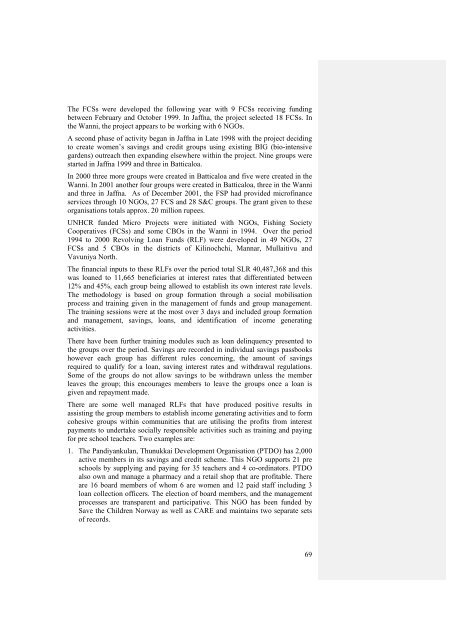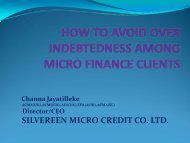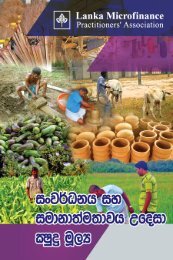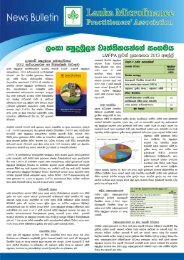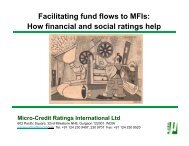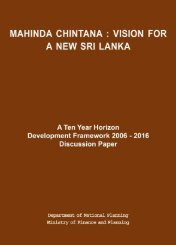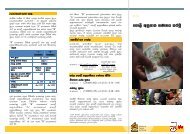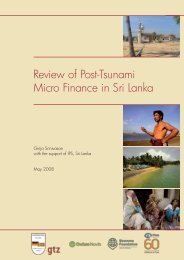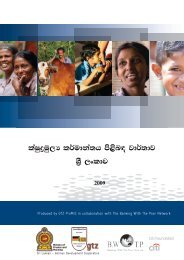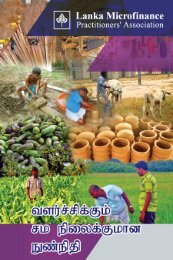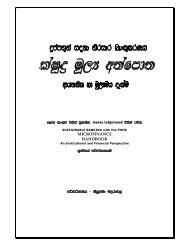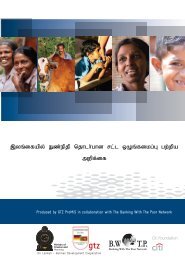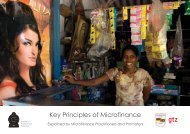National Microfinance Study of Sri Lanka: Survey of Practices and ...
National Microfinance Study of Sri Lanka: Survey of Practices and ...
National Microfinance Study of Sri Lanka: Survey of Practices and ...
Create successful ePaper yourself
Turn your PDF publications into a flip-book with our unique Google optimized e-Paper software.
The FCSs were developed the following year with 9 FCSs receiving funding<br />
between February <strong>and</strong> October 1999. In Jaffna, the project selected 18 FCSs. In<br />
the Wanni, the project appears to be working with 6 NGOs.<br />
A second phase <strong>of</strong> activity began in Jaffna in Late 1998 with the project deciding<br />
to create women’s savings <strong>and</strong> credit groups using existing BIG (bio-intensive<br />
gardens) outreach then exp<strong>and</strong>ing elsewhere within the project. Nine groups were<br />
started in Jaffna 1999 <strong>and</strong> three in Batticaloa.<br />
In 2000 three more groups were created in Batticaloa <strong>and</strong> five were created in the<br />
Wanni. In 2001 another four groups were created in Batticaloa, three in the Wanni<br />
<strong>and</strong> three in Jaffna. As <strong>of</strong> December 2001, the FSP had provided micr<strong>of</strong>inance<br />
services through 10 NGOs, 27 FCS <strong>and</strong> 28 S&C groups. The grant given to these<br />
organisations totals approx. 20 million rupees.<br />
UNHCR funded Micro Projects were initiated with NGOs, Fishing Society<br />
Cooperatives (FCSs) <strong>and</strong> some CBOs in the Wanni in 1994. Over the period<br />
1994 to 2000 Revolving Loan Funds (RLF) were developed in 49 NGOs, 27<br />
FCSs <strong>and</strong> 5 CBOs in the districts <strong>of</strong> Kilinochchi, Mannar, Mullaitivu <strong>and</strong><br />
Vavuniya North.<br />
The financial inputs to these RLFs over the period total SLR 40,487,368 <strong>and</strong> this<br />
was loaned to 11,665 beneficiaries at interest rates that differentiated between<br />
12% <strong>and</strong> 45%, each group being allowed to establish its own interest rate levels.<br />
The methodology is based on group formation through a social mobilisation<br />
process <strong>and</strong> training given in the management <strong>of</strong> funds <strong>and</strong> group management.<br />
The training sessions were at the most over 3 days <strong>and</strong> included group formation<br />
<strong>and</strong> management, savings, loans, <strong>and</strong> identification <strong>of</strong> income generating<br />
activities.<br />
There have been further training modules such as loan delinquency presented to<br />
the groups over the period. Savings are recorded in individual savings passbooks<br />
however each group has different rules concerning, the amount <strong>of</strong> savings<br />
required to qualify for a loan, saving interest rates <strong>and</strong> withdrawal regulations.<br />
Some <strong>of</strong> the groups do not allow savings to be withdrawn unless the member<br />
leaves the group; this encourages members to leave the groups once a loan is<br />
given <strong>and</strong> repayment made.<br />
There are some well managed RLFs that have produced positive results in<br />
assisting the group members to establish income generating activities <strong>and</strong> to form<br />
cohesive groups within communities that are utilising the pr<strong>of</strong>its from interest<br />
payments to undertake socially responsible activities such as training <strong>and</strong> paying<br />
for pre school teachers. Two examples are:<br />
1. The P<strong>and</strong>iyankulan, Thunukkai Development Organisation (PTDO) has 2,000<br />
active members in its savings <strong>and</strong> credit scheme. This NGO supports 21 pre<br />
schools by supplying <strong>and</strong> paying for 35 teachers <strong>and</strong> 4 co-ordinators. PTDO<br />
also own <strong>and</strong> manage a pharmacy <strong>and</strong> a retail shop that are pr<strong>of</strong>itable. There<br />
are 16 board members <strong>of</strong> whom 6 are women <strong>and</strong> 12 paid staff including 3<br />
loan collection <strong>of</strong>ficers. The election <strong>of</strong> board members, <strong>and</strong> the management<br />
processes are transparent <strong>and</strong> participative. This NGO has been funded by<br />
Save the Children Norway as well as CARE <strong>and</strong> maintains two separate sets<br />
<strong>of</strong> records.<br />
69


